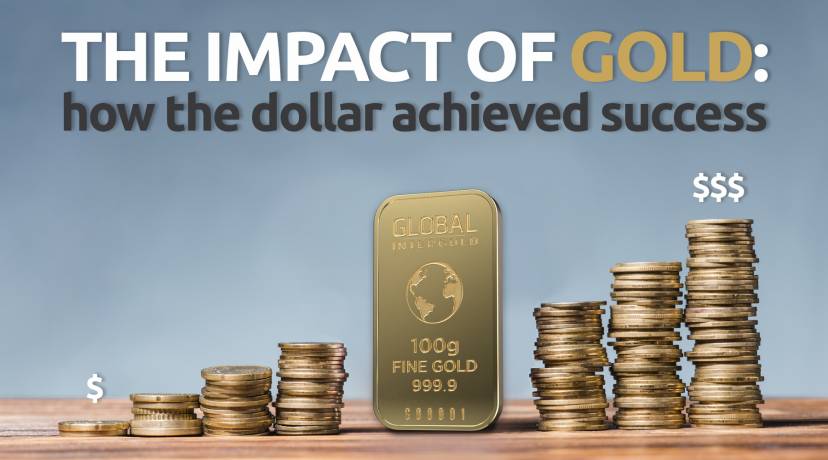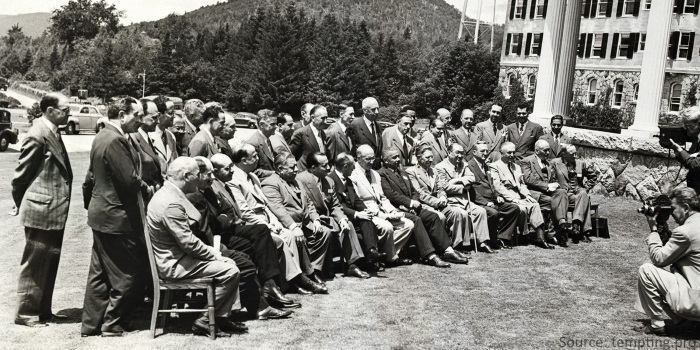The impact of gold: how the dollar achieved success

We tend to view gold and the dollar as two irreconcilable rivals. However, it was the yellow metal that helped the dollar to become the number one currency in the world.
Bretton Woods agreement
In mid-1944, when the outcome of World War II was a foregone conclusion, heads of government considered restoring the global economy. Representatives of 44 countries gathered in the American resort Bretton Woods to discuss that issue.
At that time, two-thirds of the world's gold reserves were concentrated in the United States, basically providing the country with a monopoly on the yellow metal trade. Due to a solid gold base, the dollar had become the main reserve asset and determinant of the value of other currencies.
This is how the Bretton Woods system* of monetary management came into being, according to which the dollar was exchanged for gold at a fixed rate of $35 per ounce. The value of all other currencies specified in the agreement was set in dollars. The green banknote became the predominant tool of international payments and the basis of the cash reserves of most countries.

In the photo: participants of the Bretton Woods Conference.
Heyday
The gold-dollar standard lived up to expectations: the global economy accelerated; trade relations expanded. Stable exchange rates made it possible to accurately plan business operations and forecast revenue.
According to UN statistics, before the war, world exports amounted to less than $30 billion. Thanks to the Bretton Woods system, these numbers had increased several times, reaching 127 billion by 1960.
The consequences of abandoning the system
In the 1970s, American gold reserves were already substantially inferior to the volume of US currency in circulation. The Jamaica Accords* replaced the Bretton Woods system, in which the dollar was no longer backed by the valuable metal. Exchange rates began to be determined by the ratio of supply and demand in the market and hence lost stability.
Without the “gold support”, the monetary unit of the United States started to lose its purchasing power. According to estimates by the U.S. Bureau of Labor Statistics, $1 in 1970 is equivalent to $6.62 in 2020. At the same time, the price of gold has surged nearly 42 times over the past 50 years.
In the chart: since the beginning of 2019, the price of the yellow metal in US dollars has increased by 22%.
In the absence of support provided by gold, it is becoming increasingly difficult for the dollar to maintain its global leadership. According to the IMF*, the share of US currency in international reserves has been declining over the past 20 years. No wonder influential US politicians can’t help but feel nostalgic, missing the good old days when the power of the dollar was based on gold.
Genuine value
Unlike currencies, gold is valuable in itself, as it is a rare and scarce metal/commodity. During a crisis or war, this asset does not depreciate, but increases in demand. Ultimately, gold is not controlled by any state, and today it is bought with the same willingness throughout the world as centuries ago.
The possession of the yellow metal protects the owner from economic shocks, preventing the depreciation of savings. No wonder countries with the largest gold reserves have the most powerful economies.
Similarly, a noble metal can provide prosperity to any person or family. Creation of a personal gold reserve is a proven way to protect savings and strengthen Financial Security.
Glossary:
*The Bretton Woods system — an international system intended to govern monetary relations and trade settlements (1944-1976). The main principle: the US dollar remains an international means of payment that is backed by gold.
*Jamaica Accords (a floating exchange rate) — the international system with non-fixed exchange rates determined by the market and not by the state.
*IMF (International Monetary Fund) — a specialized agency of the United Nations that monitors the stability of the global financial system and provides loans to countries.
![[VIDEO] Young investors choose gold
[VIDEO] Young investors choose gold](https://f01.gig-os.com/74/2c/cc/2b/74/742ccc2b74d465054d6aed797b9de6a1_5.jpg?1)
![[VIDEO] The US legalizes payments in gold [VIDEO] The US legalizes payments in gold](https://f01.gig-os.com/cf/b1/ba/70/55/cfb1ba7055dd2524218f5aabd01efea8_5.webp?1)
![[VIDEO] Record gold demand: market situation in Q1 2025
[VIDEO] Record gold demand: market situation in Q1 2025](https://f01.gig-os.com/0d/85/47/0b/15/0d85470b15a79bc2aabf122c0d401060_5.webp?1)
![[VIDEO] Investors in Asia are buying up gold!
[VIDEO] Investors in Asia are buying up gold!](https://f01.gig-os.com/45/45/84/6f/73/4545846f738945417567ffd2f6f163bb_5.webp?1)
![[VIDEO] Gold price has increased 9 times since the early 2000s!
[VIDEO] Gold price has increased 9 times since the early 2000s!](https://f01.gig-os.com/47/af/07/eb/bb/47af07ebbb01542f14c0aae36a81f1c0_5.webp?1)
![[VIDEO] The US is urgently increasing gold mining — what’s going on? [VIDEO] The US is urgently increasing gold mining — what’s going on?](https://f01.gig-os.com/43/06/89/4d/da/4306894dda97c98b6e595409af58b694_5.webp?1)
![[VIDEO] China sets trends in the global gold market
[VIDEO] China sets trends in the global gold market](https://f01.gig-os.com/5b/81/78/92/92/5b81789292d5e49f20ca7ca093a27cbe_5.jpg?1)
![[VIDEO] Central banks acquired a quarter of the world's gold!
[VIDEO] Central banks acquired a quarter of the world's gold!](https://f01.gig-os.com/81/2d/76/ff/b0/812d76ffb00ee75856059a67a872642c_5.webp?1)
![[VIDEO] Gold: new records amid market volatility
[VIDEO] Gold: new records amid market volatility](https://f01.gig-os.com/03/8b/98/61/b7/038b9861b74be1ae5d57e56e2d2dc859_5.webp?1)
![[VIDEO] Depreciation of money: how to preserve capital? [VIDEO] Depreciation of money: how to preserve capital?](https://f01.gig-os.com/f9/05/87/f3/5d/f90587f35d2d7a1df8880c220372ab8b_5.webp?1)